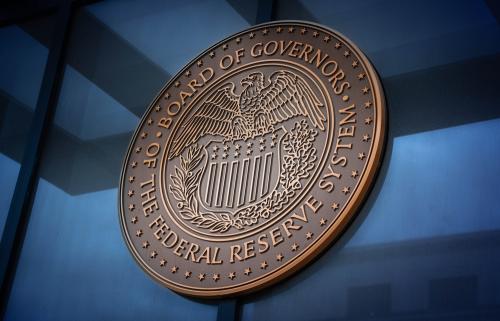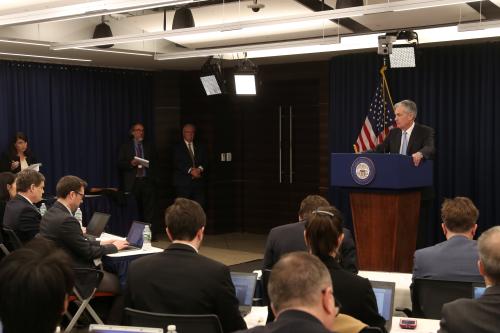The paper summarized here is part of the spring 2025 edition of the Brookings Papers on Economic Activity, the leading conference series and journal in economics for timely, cutting-edge research about real-world policy issues. Research findings are presented in a clear and accessible style to maximize their impact on economic understanding and policymaking. The editors are Brookings Nonresident Senior Fellows Janice Eberly and Jón Steinsson.
See the spring 2025 BPEA event page to watch paper presentations and read summaries of all the papers from this edition. Submit a proposal to present at a future BPEA conference here.
Thinly capitalized hedge funds’ growing role in the enormous and rapidly expanding market for U.S. Treasury securities poses a clear and present danger to financial stability that warrants a new approach from the Federal Reserve during times of extreme market stress, suggests a paper discussed at the Brookings Papers on Economic Activity (BPEA) conference on March 28.
In their paper, “Treasury Market Dysfunction and the Role of the Central Bank,” the authors examine changes in the Treasury market since March 2020, when the Federal Reserve purchased more than $4 trillion of Treasuries and government-backed mortgage securities to calm turmoil in those markets triggered by the COVID pandemic.
“These problems threatened to spill over into other markets as well, potentially interrupting the smooth flow of credit and impairing the implementation of monetary policy,” write the authors, Anil K Kashyap of the University of Chicago, Jeremy C. Stein and Jonathan L. Wallen of Harvard University, and Joshua Younger of Columbia University. “It is natural to wonder whether such episodes of fragility will become more frequent and/or more severe as the Treasury market continues to grow.”
U.S. Treasury debt held by the public reached $28.3 trillion (96% of gross domestic product) by the third quarter of 2024 and continues to climb rapidly, the authors note. They developed a model to examine the incentives and constraints facing three types of institutions in the Treasury market: asset managers such as bond mutual funds, pension funds and insurance companies; broker-dealers; and hedge funds. And they offer recommendations for how the Federal Reserve can best address future episodes of turmoil.
To meet future obligations, asset managers invest directly in Treasury bonds and indirectly through derivatives such as futures and swaps. Both their direct holdings and derivative positions are “long,” meaning they are exposed to losses if interest rates rise and the value of their holdings and positions falls.
Broker-dealers and, increasingly, hedge funds in essence lend their balance sheets to the asset managers. They directly hold the Treasury securities that the asset managers prefer to hold synthetically through derivatives. The hedge funds and broker-dealers hedge their direct holdings by taking a “short” position in derivatives (the opposite of the asset managers). If interest rates rise and the value of their direct holdings declines, then the value of their derivatives positions increases to offset the direct holdings’ decline. The dealers and hedge funds are compensated for this service through the spread, known as a “cash-futures basis,” between the returns on Treasuries and Treasury derivatives.
The vulnerability arises because the hedge funds, which are more lightly regulated than broker-dealers, finance their Treasury holdings almost entirely by borrowing against them. Thus, any number of shocks can lead the hedge funds to quickly exit the trade, requiring the broker-dealers to step in, at least in the short term.
The authors recommend that the Federal Reserve, in periods of extreme stress, be prepared to take over the hedge funds’ positions. As before, the Fed could stand ready to purchase Treasury securities but it would also, as the hedge funds do, take offsetting short positions in derivatives.
The primary advantage of that approach for the Fed, they write, is that the purchases would be self-liquidating because the reversal of the securities purchases would be embedded in the short positions in derivatives. The Fed would not, as it has had to do during the COVID-era, worry about how to reduce its holdings once market stress subsides. And, because the purchases would be hedged, the Fed would not have to take a loss on those holdings if it has to raise interest rates to quell inflation, as it did in the aftermath of the pandemic.
Also, this new approach would be strictly focused on market functioning, preserving the distinction with monetary policy actions to support economic growth and employment, they write. Because the purchases would be hedged, they would not—as the Fed’s COVID-era purchases did—put upward pressure on growth and inflation by pushing down long-term interest rates.
CITATION
Kashyap, Anil K, Jeremy C. Stein, Jonathan L. Wallen, and Joshua Younger. 2025. “Treasury Market Dysfunction and the Role of the Central Bank.” BPEA Conference Draft, Spring.
-
Acknowledgements and disclosures
David Skidmore authored the summary language for this paper. Chris Miller assisted with data visualization.
Kashyap receives compensation for occasional speaking engagements with financial services firms. Younger contributed to this paper while he was a senior policy advisor at the Federal Reserve Bank of New York and a lecturer in law at Columbia University. As of February 3, 2025, he is employed at Tudor Investment Corporation, a Brookings donor (Tudor’s longstanding financial support to Brookings is not in any way related to this article or Younger’s authorship). The authors did not receive financial support from any firm or person for this paper. The views expressed in the paper are the authors’ own and do not necessarily represent the views of the Tudor Investment Corporation, the Federal Reserve Bank of New York, or the Federal Reserve System. Brookings is committed to quality, independence, and impact in all of its work. Activities supported by its donors reflect this commitment and the analysis and recommendations are solely determined by the scholar(s).
The Brookings Institution is committed to quality, independence, and impact.
We are supported by a diverse array of funders. In line with our values and policies, each Brookings publication represents the sole views of its author(s).







